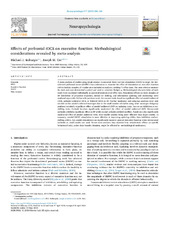| dc.creator | Imburgio, Michael | |
| dc.creator | Orr, Joseph | |
| dc.date.accessioned | 2020-05-27T16:53:02Z | |
| dc.date.available | 2020-05-27T16:53:02Z | |
| dc.date.issued | 2018-08-01 | |
| dc.identifier.citation | Imburgio, MJ & Orr JM (2018) Effects of prefrontal tDCS on executive function: Methodological considerations revealed by meta-analysis. Neuropsychologia, 117, 156-166. https://doi.org/10.1016/j.neuropsychologia.2018.04.022 | en |
| dc.identifier.uri | https://hdl.handle.net/1969.1/188024 | |
| dc.description.abstract | A meta-analysis of studies using single-session transcranial direct current stimulation (tDCS) to target the dorsolateral prefrontal cortex (DLPFC) was undertaken to examine the effect of stimulation on executive function (EF) in healthy samples. 27 studies were included in analyses, yielding 71 effect sizes. The most relevant measure for each task was determined a priori and used to calculate Hedge's g. Methodological characteristics of each study were examined individually as potential moderators of effect size. Stimulation effects on three domains of EF (inhibition of prepotent responses, mental set shifting, and information updating and monitoring) were analyzed separately. In line with previous work, the current study found no significant effect of anodal unilateral tDCS, cathodal unilateral tDCS, or bilateral tDCS on EF. Further moderator and subgroup analyses were only carried out for anodal unilateral montages due to the small number of studies using other montages. Subgroup analyses revealed a significant effect of anodal unilateral tDCS on updating tasks, but not on inhibition or set-shifting tasks. Cathode location significantly moderated the effect of anodal unilateral tDCS. Extracranial cathodes yielded a significant effect on EF while cranial cathodes yielded no effect. Anode size also significantly moderated effect of anodal unilateral tDCS, with smaller anodes being more effective than larger anodes. In summary, anodal DLPFC stimulation is more effective at improving updating ability than inhibition and set-shifting ability, but anodal stimulation can significantly improve general executive function when extracranial cathodes or small anodes are used. Future meta-analyses may examine how stimulation's effects on specific behavioral tasks, rather than broader domains, might be affected by methodological moderators. | en |
| dc.language.iso | en_US | |
| dc.publisher | Neuropsychologia | |
| dc.rights | Attribution-NonCommercial-ShareAlike 4.0 International | en |
| dc.rights.uri | http://creativecommons.org/licenses/by-nc-sa/4.0/ | |
| dc.subject | brain stimulation | en |
| dc.subject | executive function | en |
| dc.subject | prefrontal cortex | en |
| dc.subject | meta analysis | en |
| dc.title | Effects of prefrontal tDCS on executive function: Methodological considerations revealed by meta-analysis | en |
| dc.type | Article | en |
| local.department | Psychology | en |
| dc.identifier.doi | 10.1016/j.neuropsychologia.2018.04.022 | |



